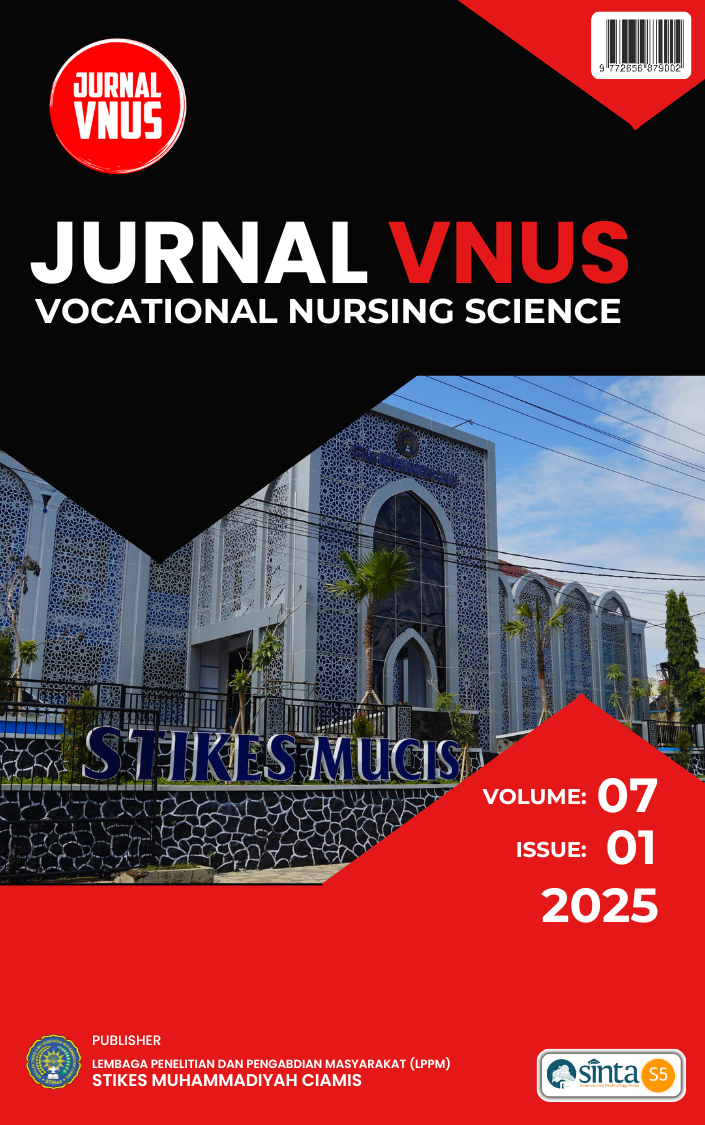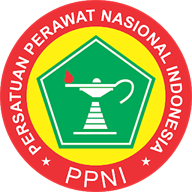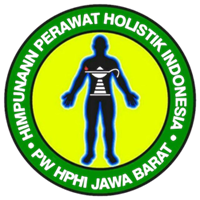Case Study: Evaluation of Menstrual Cycle Changes and Anxiety in Mothers Who Are Family Planning Acceptors Using Injectable Contraceptives
DOI:
https://doi.org/10.52221/jvnus.v7i1.578Keywords:
Injectable contraceptives, menstrual cycle changes, anxiety, family planningAbstract
Family planning is a health service that helps individuals and couples control fertility, prevent unplanned pregnancies, and determine the number and spacing of children. According to the World Health Organization (WHO), injectable contraceptives are the most widely used method globally, accounting for 35.3% of contraceptive users. Despite their effectiveness, injectable contraceptives are associated with side effects, including changes in the menstrual cycle, which can lead to anxiety among users. This case study aims to scientifically document nursing care for mothers using injectable contraceptives, focusing on the biological, psychological, social, and spiritual aspects. It emphasizes the importance of comprehensive nursing assessment, diagnosis, planning, intervention, evaluation, and documentation to support maternal and family health. The descriptive case study method was applied to explore changes in the menstrual cycle and anxiety in mothers using injectable contraceptives. Data collection involved interviews, physical examinations, observation, document review, demographic data, and quality of life questionnaires. Data validity was maintained using credibility, transferability, dependability, and confirmability criteria. Ethical considerations included informed consent, anonymity, and confidentiality. Data were analyzed systematically to identify key findings. Findings indicated that menstrual disturbances in mothers were linked to the hormonal effects of injectable contraceptives, specifically the impact of progesterone on the hypothalamic-pituitary axis, leading to suppression of ovulation and alteration of menstrual patterns. Nursing interventions contributed to a reduction in anxiety and improvement in menstrual regulation. Proper nursing care, guided by structured assessment and ongoing evaluation, can address anxiety and menstrual issues related to injectable contraceptive use. Continued documentation is essential for ensuring the effectiveness and continuity of care.
Downloads
References
Afiyanti, Y. (2010). Analisis konsep kualitas hidup. Jurnal Keperawatan Indonesia, 13(2), 81–86. https://doi.org/10.7454/jki.v13i2.236
Ambarwati, E. R., & Rahmawati, I. (2020). Promosi kesehatan tentang keluarga berencana pada wanita usia subur sebagai upaya awal untuk mewujudkan keluarga berkualitas. Jurnal Bakti Masyarakat Indonesia, 3(1), 293–299. https://doi.org/10.24912/jbmi.v3i1.8057
Andika, F., Darni, E., Adela, R., & Oktaviani, R. (2022). Edukasi tentang isu permasalahan kesehatan di Indonesia bersama calon tenaga kesehatan masyarakat Provinsi Aceh. Jurnal Pengabdian Masyarakat (Kesehatan), 4(1), 39–44.
Astutik, N. (2023). Pengaruh kontrasepsi depo medroxyprogesterone acetate terhadap IMT pada akseptor KB di Desa Sanggra Agung. Seminar Nasional Hasil Riset dan Pengabdian kepada Masyarakat (SNHRP), (2022), 2495–2502.
Cahyani. (2018). Faktor-faktor penggunaan MKJP pada PUS. Jurnal Mahasiswa BK, 1(69), 5–24.
Dharma, K. H. (2012). Pendekatan, jenis, dan metode penelitian pendidikan. Ditjen PMPTK.
Hartanto. (2019). Konsep pasangan usia subur. Jakarta: BKKBN.
Ilham, M. A., Aruan, D., Anggraini, N., & Wulandari, A. (2022). Gangguan siklus menstruasi pada remaja: Literature review. Jurnal Penelitian Perawat Profesional, 5(1), 185–192.
Karimang, S., Abeng, T. D. E., & Silolonga, W. N. (2020). Faktor yang berhubungan dengan penggunaan kontrasepsi suntik 3 bulan di wilayah Puskesmas Tagulandang Kabupaten Sitaro. Jurnal Keperawatan, 8(1), 10. https://doi.org/10.35790/jkp.v8i1.28407
Kementerian Kesehatan Republik Indonesia. (2023). Keluarga berencana. Jurnal Kesehatan, (2), 1–8.
Koerniawan, D., Daeli, N. E., & Srimiyati, S. (2020). Aplikasi standar proses keperawatan: Diagnosis, outcome, dan intervensi pada asuhan keperawatan. Jurnal Keperawatan Silampari, 3(2), 739–751. https://doi.org/10.31539/jks.v3i2.1198
Laratmase, A. J. (2016). Pengembangan alat ukur kualitas hidup nelayan. Jurnal Ilmiah Pendidikan Lingkungan dan Pembangunan, 17(1), 34–41. https://doi.org/10.21009/plpb.171.04
Limpele, I. A., Telew, A., & Mamuaja, P. (2020). Hubungan penggunaan alat kontrasepsi KB suntik dengan gangguan menstruasi pada pengguna KB suntik di Desa Eris. Jurnal Kesehatan Masyarakat UNIMA, 1(2), 29–36.
Maros, H., & Juniar, S. (2021). Kontrasepsi suntik DMPA (Depo Medroksi Progesteron Asetat). Jurnal Keluarga Berencana, 1–23.
Masruroh, N., & Laili, U. (2018). Analysis of factors that influence the selection of long-term contraception methods in postpartum mother in BPM Bashori Surabaya. Jurnal Kesehatan Al-Irsyad, 11(2), 1–9.
Mekarisce, A. A. (2020). Teknik pemeriksaan keabsahan data pada penelitian kualitatif di bidang kesehatan masyarakat. Jurnal Ilmiah Kesehatan Masyarakat: Media Komunikasi Komunitas Kesehatan Masyarakat, 12(3), 145–151. https://doi.org/10.52022/jikm.v12i3.102
Prawita, A. A., & Gulo, A. S. (2019). Hubungan penggunaan kontrasepsi suntik 3 bulan dengan kenaikan berat badan ibu di Klinik Linez Kota Gunungsitoli. Jurnal Bidan Komunitas, 2(3). https://doi.org/10.33085/jbk.v2i3.4469
Putri, N. K. Y. (2020). Studi literatur hubungan lama menstruasi dengan kadar hemoglobin pada remaja putri. Jurnal Kesehatan, 5–18.
Safitri, I., & Ermawati, F. (2024). (Referensi tidak lengkap, mohon lengkapi judul artikel dan jurnalnya untuk penyesuaian sesuai APA Style).
Santa, A. (2019). Evaluasi tindakan keperawatan berdasarkan hasil implementasi. Jurnal Keperawatan Modern, 5(1), 50–59. (Tambahan sesuai kutipan pada artikel).
Downloads
Published
How to Cite
Issue
Section
License
Copyright (c) 2025 Elis Roslianti, Amelia Fitri, Neli Sunarni, Yanti Srinayanti

This work is licensed under a Creative Commons Attribution 4.0 International License.















